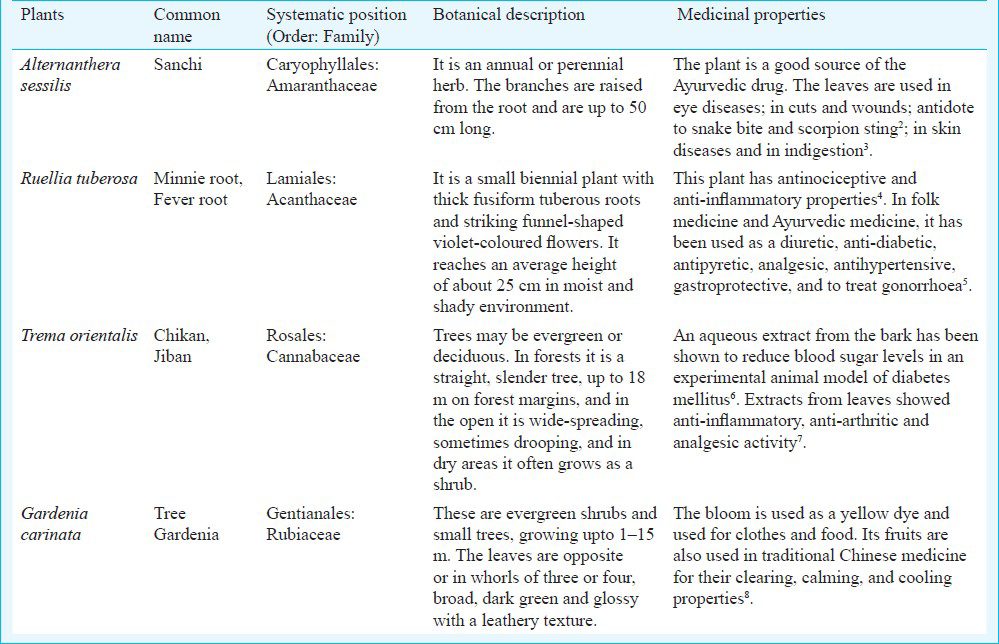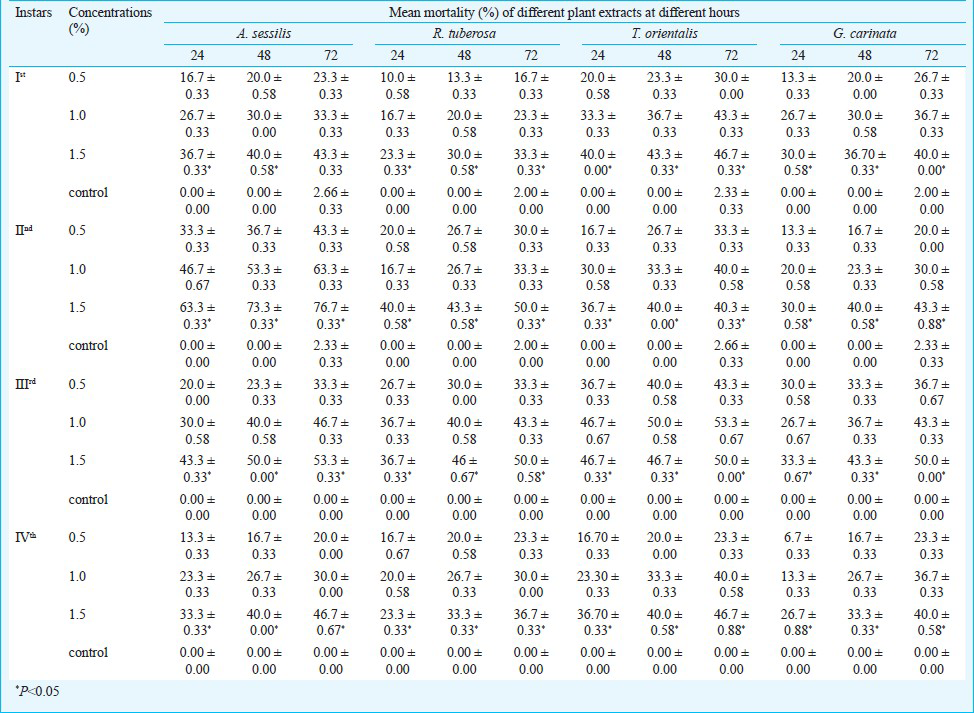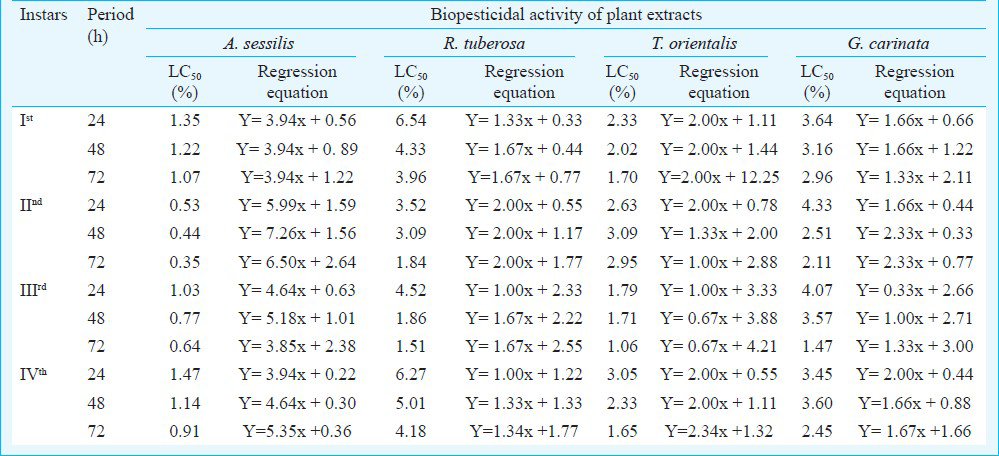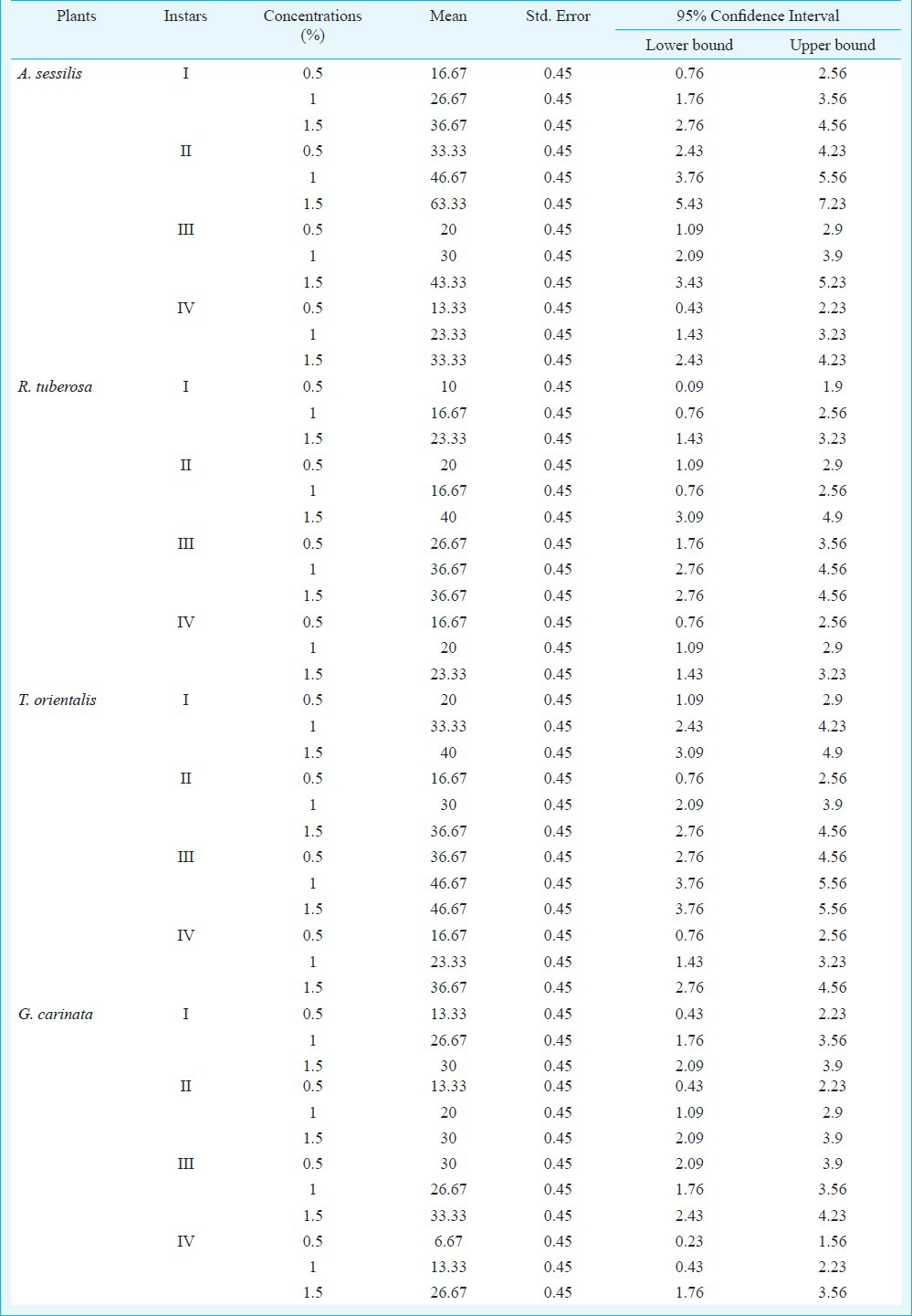Translate this page into:
Mosquito larvicidal potential of four common medicinal plants of India
Reprint requests: Dr Goutam Chandra, Professor, Department of Zoology, Mosquito & Microbiology Research Units Parasitology Laboratory, The University of Burdwan, Golapbag, Burdwan 713 104, India e-mail: goutamchandra63@yahoo.co.in
-
Received: ,
This is an open-access article distributed under the terms of the Creative Commons Attribution-Noncommercial-Share Alike 3.0 Unported, which permits unrestricted use, distribution, and reproduction in any medium, provided the original work is properly cited.
This article was originally published by Medknow Publications & Media Pvt Ltd and was migrated to Scientific Scholar after the change of Publisher.
Abstract
Background & objectives:
Mosquitoes transmit serious human health diseases, causing millions of deaths every year. Plants may be sources of alternative mosquito control agents. The present study was carried out to assess the role of larvicidal activities of the crude extracts of four plants viz. Alternanthera sessilis L. (Amaranthaceae), Trema orientalis L. (Cannabaceae), Gardenia carinata Smith. (Rubiaceae) and Ruellia tuberosa L. (Acanthaceae) against Culex quinquefasciatus Say in laboratory bioassay.
Methods:
Selective concentrations (0.5, 1 and 1.5%) of crude extract of all four plant leaves were tested against Ist to IVth instar larvae of Cx. quinquefasciatus. Log probit analysis (at 95% confidence level) revealed the LC50 values. Preliminary qualitative phytochemical analyses of crude extracts were also done. The lethal concentrations (%) of crude extracts at 24 h against IIIrd instar larvae were also studied on non-target organisms.
Result:
In a 72 h bioassay experiment with crude extract, the highest mortality was recorded in 1.5 per cent extract. A. sessilis showed the highest mortality (76.7 %) at 1.5 per cent crude extract against IInd instar larvae having LC50 value of 0.35 per cent, followed by R. tuberosa (LC50 =1.84%), G. carinata (LC50 = 2.11) and T. orientalis (LC50 = 2.95%). The regression equation showed a dose-dependent mortality, as the rate of mortality (Y) was positively correlated with the concentration (X). Phytochemical analysis of the crude extract showed the presence of many bioactive phytochemicals such as steroids, alkaloids, terpenes, saponins, etc. No changes in the swimming behaviour and survivality of non-target organism were noticed at the studied concentrations.
Interpretation & conclusions:
Crude extract of the four selected plants showed larvicidal activity against Cx. quinquefasciatus. The extracts at the studied concentrations did not produce any harmful effect on non-target organisms.
Keywords
Culex quinquefasciatus
larvicidal activity
non-target organisms
phytochemical analysis
Vector control is an essential requirement in control of epidemic diseases such as malaria, filariasis, dengue, etc. that are transmitted by mosquitoes. Excessive use of synthetic pesticides causes emergence of pesticide resistance and harmful effect on non-target organisms. This has necessitated an urgent search for development of new and improved mosquito control methods that are economical and effective as well as safe for non-target organisms and the environment. Herbal insecticides of plant origin become a priority in this search. Several laboratory and field based studies have already been carried out in this area and some potentially active larvicides of plant origin like octacosane, falcarinol, geranial, azadirachtin, pipernonaline plumbagin, β-sitosterol, etc. have been isolated so far1.
The objective of present study was to evaluate the larvicidal activity of the crude extracts of four plants viz. Alternanthera sessilis L. (Amaranthaceae), Trema orientalis L. (Cannabaceae), Gardenia carinata Smith. (Rubiaceae) and Ruellia tuberosa L. (Acanthaceae) on Culex quinquefasciatus as target species. Their medicinal properties are presented in Table I2345678. Qualitative analysis of the crude plant extracts was also done to have an idea about the chemical profile of active ingredient (s).

Material & Methods
The present study was conducted in the department of Zoology, University of Burdwan, at Burdwan, West Bengal, India during April-June 2011. Mosquito larvae available in the cemented drains surrounding the University campus were collected by 250 ml dipper9. Majority of the larvae were of the species Cx. quinquefasciatus and a few were Armigeres subalbatus. Larvae were reared to adult stage and identified101112. Collected larvae were kept in the plastic bucket (20 l) with the addition of artificial food (powdered mixture of dog biscuits and dried yeast powder in the ratio of 3:1), and aquatic weeds kept free from exposure to pathogens, insecticides, or repellants and maintained at 31-33°C temperature and 85 per cent relative humidity (RH). Some of the previously identified larvae were also reared upto the adult stages to confirm their species identity.
Preparation of crude extract: Fresh, mature, green leaves of all the selected plants were collected during April – June, 2011, from plants growing on the outskirts of Burdwan and authenticated by Dr Ambarish Mukherjee, Professor in Botany, University of Burdwan, West Bengal, India. After collection, all the leaves were initially rinsed with distilled water and dried on paper towel. Wet weight quantities (50 g) of plant leaves were crushed with a mixer-grinder machine, and the juice was filtered by Whatman No. 1 filter paper. The clear filtrate was used as a stock solution (100% concentration of crude extract) for bioassays experiments. Required concentrations (0.5, 1 and 1.5%) were prepared using sterilized distilled water.
Dose-response larvicidal bioassay: The larvicidal bioassay was done following the World Health Organization13 standard protocols with suitable modifications. Each of the earlier prepared concentrations of crude extract was transferred into the sterile glass Petri-dishes (9 cm diameter/150 ml capacity). The first-, second-, third-, and fourth-instar larval forms of Cx. quinquefasciatus (20 each) were separately introduced into different Petri-dishes containing appropriate concentrations, 20 mg of larval food (dried yeast powder) was added per Petri dish. Mortality rates were recorded after 24, 48, and 72 h post-exposure. The experiments were replicated thrice at three different days and conducted at 25-30°C and 80-90 per cent RH. A set of control experiment (without having the test solution) using tap water was also run parallel.
Phytochemical analysis of the plant extracts: Crude extracts of all four plants were subjected to qualitative phytochemical analysis141516. The phytochemicals analysed were saponins, terpenoids, alkaloid, steroids, tannin, flavonoids and cardiac glycosides.
Effect on non-target organisms: The crude extracts of all the plant leaves were tested against two non-target invertebrates, Diplonychus annulatum (5th instar larval forms) and Chironomus circumdatus present in the same habitat of the mosquito larvae. As per the procedure used by Suwannee et al17, the non-targets were exposed to the sub lethal dose, LC50 (at 24 h for 3rd instar larvae of Cx. quinquefasciatus) of the crude extract. Ten early 4th instar chironomid larvae were placed in a plastic tray containing 200 ml pond water with mud. Ten 3rd instar nymph of D. annulaum were kept in pond water in a plastic tray (12.6 × 10 × 6 inches). Numbers of dead were recorded after 24 h, 48 h and 72 h of exposure and percentage mortality was recorded. Each experiment was replicated thrice. A set of control (without having the test solution) for each organism was run parallel.
Statistical analysis: The percentage mortality observed was corrected by Abbott's formula18. Statistical analysis of the experimental data was performed using the computer software “STAT PLUS 2007 (Trial version: http://statplus.en.softonic.com)” and “MS EXCEL 2007” to find out the (Log probit analysis (at 95% confidence level), regression equations and mean percentage mortality. Comparison of mean percentage mortality, standard error and their upper and lower bound at 95 per cent confidence level are estimated by Tukey and Duncae test.
Results
Highest mortality was seen at 1.5 per cent concentration of crude extract, tested against all larval instar and was significantly higher (P < 0.05) than 0.5 and 1 per cent concentrations at 24, 48 and 72 h of exposure (Table II). The relative efficacy of the plant extracts against target species was as follows: A. sessilis > T. orientalis > G. carinata > R. tuberosa leaf extract. The result of regression analysis of crude extract of all the plants showed that the mortality rate (Y) was positively correlated with concentration of exposure (X). The result of log probit analysis (95% confidence level) showed that LC50 values gradually decreased with exposure periods and a lowest value at 72 h exposure to IInd instar followed by IIIrd, IVth and Ist instar larvae (Table III). Comparison of mean percentage mortality of 1st–IVth instars of Cx. quinquefasciatus larvae at different test concentration of tested plants, standard error and their upper and lower bound at 95 % confidence level are presented in Table IV. No changes in the survival rate and swimming activity of the non target organisms were observed within 72 h post exposure. The results of preliminary qualitative phytochemical analysis of tested plant revealed the presence of some secondary metabolite that may be responsible for their biocontrol potentiality (Table V).




Discussion
The mosquito borne parasites are continually developing resistance to the available insecticides and at present, there is no vaccine to prevent infections transmitted by mosquitoes. Vector control in the larval condition is the best available option as the larvae are confined to water bodies which are mainly man made and can be easily located. Furthermore, for the protection of environment and other non-target organisms which share same habitat with the mosquito larvae, plant based insecticides are in demand for mosquito control as synthetic insecticides are non-biodegradable, toxic to environment and also responsible for resistance19. Testing the plant crude extracts against mosquito can lead to identify potential bioactive compounds that can be used as larvicides to control mosquito. Botanical derivatives have drawn attention as potential insect control agents targeting only larval stages in the mosquito control programme in the last three decades202122.
The findings of the present investigation indicated that 1.5 per cent crude extract of mature leaves of A. sessilis showed highest mortality against IInd instar larvae of Cx. quinquefasciatus. T. orientalis showed 53.3 per cent mortality against IIIrd instar, G. carinata showed 50 per cent mortality against IIIrd instar and R. tuberosa showed 50 per cent mortality in IInd and IIIrd instar larvae after 72 h, respectively. The phytochemical analysis of the plant extracts revealed the presence of several bioactive secondary metabolites that singly or in combinations may be responsible for the larval toxicity. As no mortality occured in the non-target organisms, it was assumed that tested plant extracts were safe to use in the aquatic ecosystem.
Green synthesis of pesticides of biological origin may serve as suitable alternatives to synthetic or chemical insecticides in future as these are relatively safe, inexpensive, and are readily available in many areas of the world. Plant shows a vast range of phytochemicals which may be used in place of chemical pesticides due to their ecofriendly nature. Further investigations are needed to elucidate this activity against a wide range of mosquito species and also the active ingredient(s) of the extract responsible for the mosquitocidal activity.
References
- A review on natural products with mosquitocidal potentials. In: Opportunity, challenge and scope of natural products in medicinal chemistry. Trivandrum, Kerala: Trans World Publishers, Research Signpost; 2011. p. :223-53.
- [Google Scholar]
- Reviews on Indian medicinal plants. New Delhi: Indian Council of Medical Research (ICMR); 2004. p. :151-7.
- [Google Scholar]
- Treatment of acne vulgaris with new polyherbal formulations, clarina cream and purim tablets. Indian J Dermatol. 2001;46:138-41.
- [Google Scholar]
- Gastroprotective activity of Ruellia tuberosa root extract in rats. J Trop Med Plants. 2003;4:191-4.
- [Google Scholar]
- Antinociceptive and anti-inflammatory properties of Ruellia tuberosa. Pharm Biol. 2009;47:209-14.
- [Google Scholar]
- Glucose lowering efficacy of the aqueous stem bark extract of Trema orientalis (Linn) Blume in normal and streptozotocin diabetic rats. Pharmazie. 2006;61:233-6.
- [Google Scholar]
- Analgesic and antiinflammatory activity in acute and chronic conditions of Trema guineense (Schum.et Thonn) Ficalho and Trema micrantha Blume extracts in rodents. Phytother Res. 1992;6:146-8.
- [Google Scholar]
- Plant resources of South-East Asia. In: Sosef MSM, Hong LT, Prawirohatmodjo S, eds. Timber trees: lesser-known timbers. Leiden, the Netherlands: Backhuys Publishers; 1998. p. :251.
- [Google Scholar]
- Division of Malaria and other Parasitic Diseases. Manual on practical entomology in malaria. Part II: Methods and techniques. In: World Health Organization Offset Publication no. 13. Geneva: WHO; 1975.
- [Google Scholar]
- The fauna of British India, including Ceylon and Burma. Diptera vol. iv Family Culicidae. Tribes Anophelini London: Taylor and Francis; 1933. p. :371.
- [Google Scholar]
- The fauna of British India, including Ceylon and Burma. Diptera. In: Family Culicidae Tribes Megarhinini and Culicini. Vol V. London: Taylor and Francis; 1934. p. :463.
- [Google Scholar]
- Instructions for determining the susceptibility or resistance of mosquito larvae to insecticides. In: WHO/VBC/81. Geneva: WHO; 1981.
- [Google Scholar]
- Phytochemical methods. A guide to modern techniques of plant analysis. London: Chapman and Hall; 1984. p. :49-188.
- [Google Scholar]
- Pharmacognosy: a physicians guide to herbal medicine. (13th ed). London: Bailliere Tindal; 1989.
- [Google Scholar]
- Medicinal plants and traditional medicine in Africa. Ibadan, Nigeria: Spectrum Books; 1993. p. :55-71.
- [Google Scholar]
- Evaluations of larvicidal activity of medicinal plant extracts to Aedes aegypti (Diptera: Culicidae) and other effects on a non target fish. Insect Sci. 2006;13:179-88.
- [Google Scholar]
- A method of computing the effectiveness of an insecticide. J Econ Entomol. 1925;18:265-7.
- [Google Scholar]
- Harmful effects of pesticides and their control through cowpathy. Int J Cow Sci. 2006;2:61-70.
- [Google Scholar]
- Botanical derivatives in mosquito control: a review. J Am Mosq Control Assoc. 1991;7:210-37.
- [Google Scholar]
- A review of botanical phytochemicals with mosquitocidal potential. Environ Int. 2005;31:1149-66.
- [Google Scholar]
- Plant extracts as potential mosquito larvicides. Indian J Med Res. 2012;135:581-98.
- [Google Scholar]






